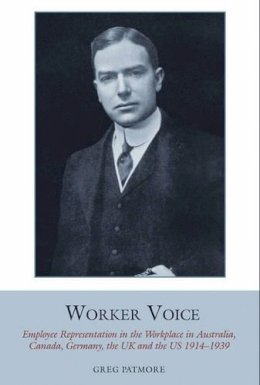
Stock image for illustration purposes only - book cover, edition or condition may vary.
Worker Voice: Employee Representation in the Workplace in Australia, Canada, Germany, the UK and the US 1914-1939 (Studies in Labour History LUP)
Greg Patmore
€ 58.50
FREE Delivery in Ireland
Description for Worker Voice: Employee Representation in the Workplace in Australia, Canada, Germany, the UK and the US 1914-1939 (Studies in Labour History LUP)
Hardcover. The book aims to understand work participation in the workplace or worker voice by examining the inter-war experience in Australia, Canada, Germany, the UK and the US. Series: Studies in Labour History. Num Pages: 256 pages. BIC Classification: 3JJF; 3JJG; HBJD; HBTK; KNXB. Category: (P) Professional & Vocational. Dimension: 234 x 156. .
An Open Access edition of this book is available on the Liverpool University Press website and the OAPEN library.
This book informs debates about worker participation in the workplace or worker voice by analysing comparative historical data relating to these ideas during the inter-war period in Australia, Canada, Germany, the UK and the US. The issue is topical because of the contemporary shift to a workplace focus in many countries without a corresponding development of infrastructure at the workplace level, and because of the growing ‘representation gap’ as union membership declines. Some commentators have called for the introduction of works councils to address these issues. Other scholars have gone back and examined the experiences with the non-union Employee Representation Plans (ERPs) in Canada and the US. This book will test these claims through examining and comparing the historical record of previous efforts of five countries during a rich period of experimentation between the Wars. In addition to ERPs, the book expands the debate will by examining union-management co-operation, Whitley works committees and German works councils.
This book informs debates about worker participation in the workplace or worker voice by analysing comparative historical data relating to these ideas during the inter-war period in Australia, Canada, Germany, the UK and the US. The issue is topical because of the contemporary shift to a workplace focus in many countries without a corresponding development of infrastructure at the workplace level, and because of the growing ‘representation gap’ as union membership declines. Some commentators have called for the introduction of works councils to address these issues. Other scholars have gone back and examined the experiences with the non-union Employee Representation Plans (ERPs) in Canada and the US. This book will test these claims through examining and comparing the historical record of previous efforts of five countries during a rich period of experimentation between the Wars. In addition to ERPs, the book expands the debate will by examining union-management co-operation, Whitley works committees and German works councils.
Product Details
Publisher
Liverpool University Press
Format
Hardback
Publication date
2016
Series
Studies in Labour History
Condition
New
Number of Pages
256
Place of Publication
Liverpool, United Kingdom
ISBN
9781781382684
SKU
V9781781382684
Shipping Time
Usually ships in 7 to 11 working days
Ref
99-50
About Greg Patmore
Greg Patmore is Professor of Business and Labour History, Work and Organisational Studies, The University of Sydney Business School.
Reviews for Worker Voice: Employee Representation in the Workplace in Australia, Canada, Germany, the UK and the US 1914-1939 (Studies in Labour History LUP)
Reviews 'A well-researched transnational history with impressive detail.' Chris Wrigley, University of Nottingham 'Patmore believes that understanding the past can and should influence the present and describing how a similar issue played out across five countries makes the stories he tells in Worker Voice much more important than had he chosen to describe the ERP situation in just one nation. This kind of ambition deserves to be applauded.' Jonathan Rees, Labour / Le Travail 'Greg Patmore has produced a clear and accessible book, whichprovides the reader with a detailed, yet succinct, account of the different forms ofemployee representation found in the five selected countries. It is a book that I would warmly recommend to anyone interested in this turbulent period of international labour history.' Ed Blissett, Labour History
